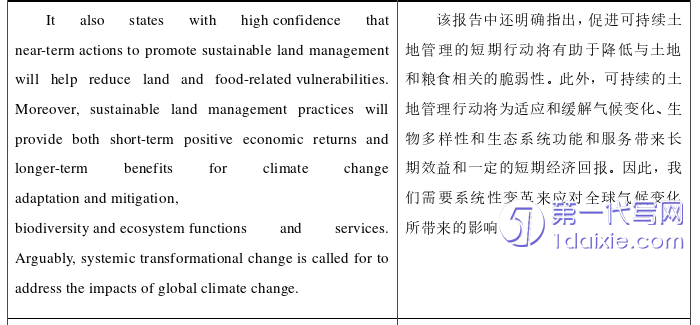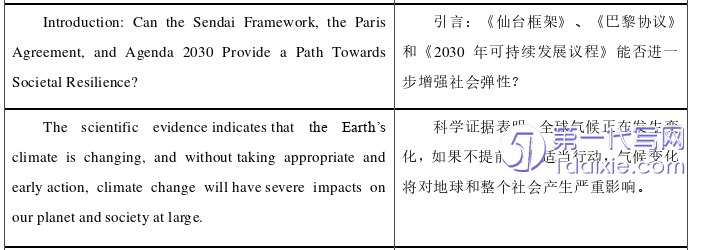本文是一篇英语论文,本报告通过处理翻译过程中遇到的这些困难,译者获得了许多宝贵的经验。任何翻译工作都离不开大量的译前准备工作,这不仅有利于充分理解原文内容,也有利于后续翻译工作的顺利开展。
Chapter One Task Description
1.1 Background Information of the Translation Task
In 2021, many parts of the world have been hit by natural disasters such as mountain fires and floods, many of which are closely related to climate change. The report issued by the United Nations in August 2021 sets off alarm bells on the adverse effects of climate change. Cai Bentian (2022: 4) pointed out that in today‘s challenging environment, APEC and other multilateral institutions should shoulder their responsibilities and respond to challenges in a coordinated, comprehensive, and cohesive manner. It is undeniable that differences between organizations around the world are deepening. However, any differences should not prevent APEC members from uniting to jointly address such vital issues as climate change.

This original text studies that the Sendai Framework, the Paris Agreement, and Agenda 2030 offers a path towards societal resilience. This report attaches great importance on creating resilient futures.
In the first place, the study of climate change is of far-reaching significance. On one hand, the climate is the key to the sustainable survival of mankind in the future. Most human beings are eager for quick success and instant benefits. They only focus on the present benefits, regardless of the future. The study of climate change can enable people to see the future further and make full preparations for the future. Second, the research of climate change can find the factors that affect climate change. In addition to taking into account the current situation and affecting future decisions, we should see which human activities in the past have had a far-reaching impact on climate change, to judge what people should do next, reduce the impact on climate change, and make correct and effective decisions to make human beings develop better and further, and protect the earth to survive to make sure mankind will move towards an endless future.
1.2 Translation Process
Translation is an art as well as a science. If a translator wants to be competent and happy to engage in this work, he/she must strictly follow certain scientific procedures and proceed step by step to complete the translation task. The process of translation includes the pre-translation stage, the translation stage, and the post-translation stage. The relationship between the various stages is inseparable and complementary.
1.2.1 Pre-translation
It is known that good pre-translation preparation is extremely important for the successful completion of translation practice. The pre-translation stage is mainly to understand the chosen text, and understanding is the premise and foundation of expression. After skimming the whole book, the translator has a general understanding of the content of the original text. Besides, the author first selects the first section of Creating Resilient Futures for translation according to her interests and knowledge reserves as the material for translation practice report. The translator knows about the stylistic attributes of Creating Resilient Futures, the characteristics of the article‘s terms, and sentence structure. Meanwhile, the translator analyzes the original text from three aspects of language, context, and logic with a rigorous scientific attitude to capture the exact meaning of Creating Resilient Futures. In the face of polysemy, it is necessary to refer to the context to ensure the translation can be logical and reasonable.
Chapter Two Analysis of the Source Text
2.1 The Content of the Source Text
The source text is selected from the book titled Creating Resilient Futures, which comes from a foreign website (https://link.springer.com/). This website contains so many books that belong to open-access. This book is edited by Stephen Flood, Yairen Jerez Columbia, and others. It was published in 2022. This book has benefited immensely from the collaboration and exchange of ideas with colleagues at MaREI. MaREI is the Science Foundation Ireland Research Centre for Energy, Climate, and Marine research and innovation coordinated by the Environmental Research Institute (ERI) at University College Cork. The translation material mainly introduces how the Sendai Framework, the Paris Agreement, and Agenda 2030 play a role in societal resilience.
The main content of the source text is about the Sendai Framework, the Paris Agreement, and Agenda 2030 providing a path toward societal resilience. Sustainable land management actions will bring short-term economic returns and long-term benefits to climate change adaptation and mitigation, biodiversity, and ecosystem functions and services. Therefore, systemic changes are needed to address the impacts of global climate change. The COVID-19 outbreak has brought unprecedented challenges to society and the economy, overturning traditional habits and practices. At this critical juncture, we humans must confront the impacts of climate change and the realities and dangers that are beyond the capabilities of Earth‘s natural support systems. The year 2015 saw the adoption of three interconnected international frameworks: the Sendai Framework for Disaster Risk Reduction 2015–2030, the Paris Agreement under the UN Framework Convention on Climate Change (UNFCCC), and the UN‘s 2030 Agenda and the Sustainable Development Goals (SDGs). The core idea of the three agreements is to achieve economic, social, and environmental sustainability.
2.2 Features of the Source Text
The book belongs to the scientific text concerned with climate change. Therefore, the source text involves the features of academic scientific writing and scientific text. One of the features of the source text is that there are many long sentences, attributive clauses, and passive sentences. Here are some opinions about these three sentence patterns.
Concerning the features of academic scientific writing, long sentences leverage the strength of the text for academic accuracy. Long sentences are often used when stating complex concepts or interrelationships between things to express the meaning accurately (Ouyang Zhiying, 2009).
Moreover, the logic and sequence can be observed between the lines in virtue of the attributive clauses. The attributive clause is to modify some certain things. ―In the translation of attributive clauses, in order to avoid the difficulty of understanding Chinese expression due to the restriction of the original structure, special attention should be paid to ensuring the fluency of Chinese expression while accurately expressing the original meaning‖ (Widdowson, 1979:201).

Chapter Three Case Analysis .......................................... 9
3.1 Translation of Passive Sentences ................................... 9
3.1.1 Change of Voice ....................................... 9
3.1.2 Subject Addition................................ 11
Conclusion ..................................... 18
Chapter Three Case Analysis
3.1 Translation of Passive Sentences
In English scientific and technological papers, the use of passive voice is extremely common. There are two main reasons: one is that passive voice is less subjective than active voice, so it can reflect facts more objectively; the other is to explain the object clearly and prominently.
Passive voice is much more widely used in EST texts than in Chinese counterparts. Therefore, in the E-C translation of passive sentences, more attention should be paid to its unique language characteristics, which is different from the translation of literary works; it emphasizes the two principles of ―fidelity‖ and ―fluency‖ (Zou Yu, 2012: 2). ―Fidelity‖ means that the translation should be faithful to the source text and express the content of the source text accurately, completely, and scientifically. ―Fluency‖ means that translation should meet the Chinese grammatical requirements and make it easy for the readers to read.
Its characteristics should be paid attention to when translating scientific and technological texts. Unlike translating literary works, it requires translating the style of the original author and maintaining the artistic image of the original work. The translation should follow the two principles of faithfulness and smoothness. Lin Yutang once put forward three translation principles: faithfulness, coherence, and beauty. (Zhou Shibao, 2004:107-110) ―Content is more important than form‖ is one of the important criteria of scientific and technological translation (Zheng Shuming, and CaoHui, 2011:11-20). To reach these goals, the translator uses two methods as change of voice and subject addition in accordance with the source texts.
Conclusion
Based on the content of the first section of the book Creating Resilient Futures, this report first introduces the translation background and translation process, then summarizes the original text, analyzes the language characteristics of the original text, and discusses the English-Chinese translation process with specific cases in terms of sentences.
The translator has gained a lot of valuable experience by dealing with these difficulties encountered in the translation process. Any translation work is inseparable from a lot of pre-translation preparations, which is not only conducive to fully understanding the content of the original text but also conducive to the smooth development of subsequent translation work. Different translation strategies are adopted for different sentence patterns. The translated text is more readable by using the above-mentioned translation methods and strategies. At the same time, in the process of translation practice, the translator also encountered some difficulties and found some shortcomings in it.
Through this translation practice, the translator has a deeper understanding of the characteristics and translation of scientific and technological texts. From the pre-translation preparation to the translation practice process to the final polishing summary, the entire translation process has made the translator greatly improved the level of personal translation and broadened the vision. Apart from the examples mentioned in this article, there are still some problems that can be explored and studied. Finally, the translator hopes that this translation version can also provide reference for the study of the Chinese translation of similar texts.
reference(omitted)
